Note: All data and methodological notes are accessible in our GitHub repository.
Key Findings
- In 2022, 16 countries made changes to their statutory corporate income tax rates. Six countries—Colombia, South Sudan, Netherlands, Turkey, Chile, and Montenegro—increased their top
- corporate tax rates, while 10 countries—including France, Greece, and Monaco—reduced their corporate tax rates.
- Comoros (50 percent), Puerto Rico (37.5 percent), and Suriname (36 percent) are the jurisdictions with the highest corporate tax rates in the world, while Barbados (5.5 percent), Turkmenistan (8 percent), and Hungary (9 percent) levy the lowest corporate rates. Sixteen jurisdictions do not impose a corporate tax.
- The worldwide average statutory corporate income tax rate, measured across 180 jurisdictions, is 23.37 percent. When weighted by GDP, the average statutory rate is 25.43 percent.
- Asia has the lowest regional average rate at 19.52 percent, while South America has the highest regional average statutory rate at 28.38 percent. However, when weighted by GDP, Europe has the lowest regional average rate at 23.59 percent and South America has the highest at 32.64 percent.
- The average top corporate rate among EU27 countries is 21.16 percent, 23.57 percent in OECD countries, and 32 percent in the G7.
- The worldwide average statutory corporate tax rate has consistently decreased since 1980 but has leveled off in recent years.
- The average statutory corporate tax rate has declined in every region since 1980.
Table of Contents
- Introduction
- Notable Corporate Tax Rate Changes in 2022
- Scheduled Corporate Tax Rate Changes in the OECD
- The Highest and Lowest Corporate Tax Rates in the World
- Regional Variation in Corporate Tax Rates
- Distribution of Corporate Tax Rates
- The Decline of Corporate Tax Rates since 1980 Leveled off in Recent Years
- Conclusion
- Appendix
- List of all Corporate Tax Rates in 2022
Introduction
In 1980, corporate tax rates around the world averaged 40.11 percent, and 46.52 percent when weighted by GDP.[1] Since then, countries have recognized the impact that high corporate tax rates have on business investment decisions; in 2022, the average is now 23.37 percent, and 25.43 when weighted by GDP, for 180 separate tax jurisdictions.[2]
Declines have been seen in every major region of the world, including in the largest economies. In the United States, the 2017 Tax Cuts and Jobs Act brought the country’s statutory corporate income tax rate from the fourth highest in the world closer to the middle of the distribution.[3]
Asian and European countries tend to have lower corporate income tax rates than countries in other regions, and many developing countries have corporate income tax rates that are above the worldwide average.
Today, most countries have corporate tax rates below 30 percent.
Notable Corporate Tax Rate Changes in 2022
Sixteen countries changed their statutory corporate income tax rates in 2022. Six countries increased their top corporate rates: Colombia (31 percent to 35 percent), South Sudan (25 percent to 30 percent), Netherlands[4] (25 percent to 25.8 percent), Turkey (20 percent to 23 percent), Chile (10 percent to 27 percent), and Montenegro (9 percent to 15 percent).
Ten countries across four continents—Seychelles, Sierra Leone, Zambia, Bangladesh, Myanmar, Tajikistan, France, Greece, Monaco, and French Polynesia—reduced their corporate tax rates in 2022. The tax rate reductions ranged from just 1.5 percentage points in Monaco to a 5 percentage point reduction in Seychelles, Sierra Leone, Zambia, and Tajikistan.
| Country | 2021 Tax Rate | 2022 Tax Rate | Change from 2021 to 2022 |
|---|---|---|---|
| Africa | |||
| Seychelles | 30% | 25% | -5 ppt |
| Sierra Leone | 30% | 25% | -5 ppt |
| South Sudan | 25% | 30% | +5 ppt |
| Zambia | 35% | 30% | -5 ppt |
| Asia | |||
| Bangladesh | 32.5% | 30% | -2.5 ppt |
| Myanmar | 25% | 22% | -3 ppt |
| Tajikistan | 23% | 18% | -5 ppt |
| Turkey | 20% | 23% | +3 ppt |
| Europe | |||
| France | 28.4% | 25.8% | -2.6 ppt |
| Greece | 24% | 22% | -2 ppt |
| Monaco | 26.5% | 25% | -1.5 ppt |
| Montenegro | 9% | 15% | +6 ppt |
| Netherlands | 25% | 25.8% | +0.8 ppt |
| Oceania | |||
| French Polynesia | 27% | 25% | -2 ppt |
| South America | |||
| Chile * | 10% | 27% | +17 ppt |
| Colombia | 31% | 35% | +4 ppt |
| Notes:
* In response to the pandemic, Chile has adopted a temporary rate reduction to 10 percent for small businesses. In 2022, for large companies, a 27 percent corporate tax rate applies. Source: Statutory corporate income tax rates are from OECD, “Table II.1. Statutory corporate income tax rate,” updated May 2022, https://stats.oecd.org/index.aspx?DataSetCode=Table_II1; PwC, “Worldwide Tax Summaries – Corporate Taxes,” 2022, https://taxsummaries.pwc.com/. Bloomberg Tax, “Country Guides – Corporate Tax Rates,” accessed November 2022, https://www.bloomberglaw.com/product/tax/toc_view_menu/3380; and researched individually, see Tax Foundation, “worldwide-corporate-tax-rates,” GitHub, https://github.com/TaxFoundation/worldwide-corporate-tax-rates. |
|||
Scheduled Corporate Tax Rate Changes in the OECD and Selected Jurisdictions
Among Organisation for Economic Co-operation and Development (OECD) countries, Austria, the United Kingdom, and Turkey have announced they will implement changes to their statutory corporate income tax rate over the coming years. Additionally, the United Arab Emirates and South Africa also plan to amend their corporate income tax rates in 2023.
- In Austria, the corporate income tax will be cut from 25 percent to 24 percent in 2023 and further to 23 percent in 2024.[5]
- In the United Kingdom, the standard statutory corporate income tax rate is due to increase from 19 percent to 25 percent on April 1, 2023.[6]
- In Turkey, the corporate income tax was temporarily increased from 20 percent to 25 in 2021 and 23 percent in 2022. However, in 2023 the corporate income tax will return to 20 percent.[7]
- The United Arab Emirates announced the introduction of a federal corporate tax in mid-2023. The proposed corporate income tax rate of 9 percent on taxable income above AED 375,000 (USD 100,000) would apply to all business activities, while a different rate might apply to large multinationals. However, the new corporate income tax will not apply to the extraction of natural resources as these activities are already subject to taxation in the Emirates.[8]
- In South Africa, the corporate income tax will be cut from the current 28 percent to 27 percent for fiscal assessment periods that end on March 31, 2023, or after.[9]
The Highest and Lowest Corporate Tax Rates in the World
One hundred and forty-two of the 225 separate jurisdictions surveyed for the year 2022 have corporate tax rates at or below 25 percent.[10] One hundred and eighteen have tax rates above 20 percent but below or at 30 percent. The average tax rate among the 225 jurisdictions is 22.22 percent.[11] The United States has the 81st highest corporate tax rate with a combined federal and state statutory rate of 25.81 percent.[12]
The 20 countries with the highest statutory corporate income tax rates span almost every region, albeit unequally. While eight of the top 20 countries are in Africa, Oceania appears only once and Europe twice. Of the remaining jurisdictions, four are in North America, and five are in South America.
| Country | Continent | Tax Rate |
|---|---|---|
| Comoros* | Africa | 50% |
| Puerto Rico | North America | 37.5% |
| Suriname | South America | 36% |
| Argentina | South America | 35% |
| Chad | Africa | 35% |
| Colombia | South America | 35% |
| Cuba | North America | 35% |
| Equatorial Guinea | Africa | 35% |
| Guinea | Africa | 35% |
| Malta | Europe | 35% |
| Sudan | Africa | 35% |
| Sint Maarten (Dutch part) | North America | 34.5% |
| American Samoa | Oceania | 34% |
| Brazil | South America | 34% |
| Venezuela (Bolivarian Republic of) | South America | 34% |
| Cameroon | Africa | 33% |
| Saint Kitts and Nevis | North America | 33% |
| Mozambique | Africa | 32% |
| Namibia | Africa | 32% |
| Portugal | Europe | 31.5% |
|
*The normal corporate tax rate is 35 percent, which applies to both Comorian companies and foreign companies deriving Comorian-source income. However, public industrial and commercial enterprises or those where the state or certain public institutions are participants are subject to a corporate tax rate of 50 percent if their turnover exceeds 500 million Comorian francs; see Bloomberg Tax, “Country Guides: Comoros,” https://www.bloomberglaw.com/product/tax/document/25590833704. Sources: Statutory corporate income tax rates are from OECD, “Table II.1. Statutory corporate income tax rate,” updated May 2022, https://stats.oecd.org/index.aspx?DataSetCode=Table_II1; PwC, “Worldwide Tax Summaries – Corporate Taxes,” 2022, https://taxsummaries.pwc.com/. Bloomberg Tax, “Country Guides – Corporate Tax Rates,” accessed November 2022, https://www.bloomberglaw.com/product/tax/toc_view_menu/3380; and researched individually, see Tax Foundation, “worldwide-corporate-tax-rates,” GitHub, https://github.com/TaxFoundation/worldwide-corporate-tax-rates. |
||
On the other end of the spectrum, the 20 countries with the lowest non-zero statutory corporate tax rates all charge rates at or below 15 percent. Nine countries have statutory rates of 10 percent, five being small European nations (Andorra, Bosnia and Herzegovina, Bulgaria, Kosovo, and Macedonia). The only two OECD members represented among the bottom 20 countries are Hungary and Ireland. Hungary reduced its corporate income tax rate from 19 to 9 percent in 2017. Ireland is known for its low 12.5 percent rate, in place since 2003.
| (Excluding Jurisdictions with a Corporate Income Tax Rate of Zero Percent) | ||
|---|---|---|
| Country | Continent | Tax Rate |
| Barbados | North America | 5.5% |
| Turkmenistan | Asia | 8% |
| Hungary | Europe | 9% |
| Andorra | Europe | 10% |
| Bosnia and Herzegovina | Europe | 10% |
| Bulgaria | Europe | 10% |
| Kosovo, Republic of | Europe | 10% |
| Kyrgyzstan | Asia | 10% |
| Paraguay | South America | 10% |
| Qatar | Asia | 10% |
| The former Yugoslav Republic of Macedonia | Europe | 10% |
| Timor-Leste | Oceania | 10% |
| China, Macao Special Administrative Region | Asia | 12% |
| Republic of Moldova | Europe | 12% |
| Cyprus | Europe | 12.5% |
| Gibraltar | Europe | 12.5% |
| Ireland | Europe | 12.5% |
| Liechtenstein | Europe | 12.5% |
| Albania | Europe | 15% |
| Georgia | Asia | 15% |
|
Sources: OECD, “Table II.1. Statutory corporate income tax rate”; PwC, “Worldwide Tax Summaries – Corporate Taxes”; Bloomberg Tax, “Country Guides – Corporate Tax Rates”; and researched individually, see Tax Foundation, “worldwide-corporate-tax-rates.” |
||
Of the 225 jurisdictions surveyed, 16 currently do not impose a general corporate income tax. Except for the United Arab Emirates, all these jurisdictions are small, island nations. A handful, such as the Cayman Islands and Bermuda, are well known for their lack of corporate taxes.
| Country | Continent |
|---|---|
| Anguilla | North America |
| Bahamas | North America |
| Bahrain* | Asia |
| Belize* | North America |
| Bermuda | North America |
| British Virgin Islands | North America |
| Cayman Islands | North America |
| Guernsey | Europe |
| Isle of Man | Europe |
| Jersey | Europe |
| Saint Barthelemy | North America |
| Tokelau | Oceania |
| Turks and Caicos Islands | North America |
| United Arab Emirates* | Asia |
| Vanuatu | Oceania |
| Wallis and Futuna Islands | Oceania |
|
Sources: OECD, “Table II.1. Statutory corporate income tax rate”; PwC, “Worldwide Tax Summaries – Corporate Taxes”; Bloomberg Tax, “Country Guides – Corporate Tax Rates.” Notes: *Bahrain has no general corporate income tax but has a targeted corporate income tax on oil companies, which can be as high as 46 percent. See Deloitte, “International Tax – Bahrain Highlights 2022,” last updated January 2022, http://www2.deloitte.com/content/dam/Deloitte/global/Documents/Tax/dttl-tax-bahrainhighlights-2022.pdf. In Belize the corporate tax rate is 40% but as this rate applies only to the petroleum industry, the corporate tax rate in Belize has been included in this database as 0% to ensure consistency of treatment across all jurisdictions. See OECD, “Corporate Tax Statistics: Fourth Edition”, November 2022, https://www.oecd.org/tax/tax-policy/corporate-tax-statistics-fourth-edition.pdf. The United Arab Emirates is a federation of seven separate emirates. Since 1960, each emirate has the discretion to levy up to a 55 percent corporate tax rate on any business. In practice, this tax is mostly levied on foreign banks and petroleum companies. For more information on the taxation system in the United Arab Emirates, see PwC, “Worldwide Tax Summaries – Corporate income tax (CIT) rates.” |
|
Regional Variation in Corporate Tax Rates
Corporate tax rates can vary significantly by region. South America has the highest average statutory corporate tax rate among all regions at 28.38 percent. Asia has the lowest average statutory corporate tax rate among all regions at 19.52 percent.
When weighted by GDP, South America has the highest average statutory corporate tax rate at 32.64 percent, while Europe has the lowest at 23.59 percent.
In general, larger and more industrialized nations tend to have higher corporate income tax rates than smaller nations. The G7, which is comprised of the seven wealthiest nations in the world, has an average statutory corporate income tax rate of 26.77 percent and a weighted average rate of 26.24 percent. OECD member states have an average statutory corporate tax rate of 23.57 percent and a rate of 25.83 percent when weighted by GDP. The BRICS[13] have an average statutory rate of 27.40 percent and a weighted average statutory corporate income tax rate of 26.06 percent.
| Region | Average Rate | Average Rate Weighted by GDP | Number of Countries Covered |
|---|---|---|---|
| Africa | 27.60% | 27.50% | 50 |
| Asia | 19.52% | 24.93% | 47 |
| Europe | 19.74% | 23.59% | 39 |
| North America | 25.33% | 26.13% | 24 |
| Oceania | 23.75% | 29.72% | 8 |
| South America | 28.38% | 32.64% | 12 |
| G7 | 26.32% | 26.22% | 7 |
| OECD | 23.57% | 25.83% | 38 |
| BRICS | 27.40% | 26.06% | 5 |
| EU27 | 21.16% | 25.28% | 27 |
| G20 | 26.77% | 26.24% | 19 |
| World | 23.37% | 25.43% | 180 |
|
Sources: Statutory corporate income tax rates are from OECD, “Table II.1. Statutory corporate income tax rate”; PwC, “Worldwide Tax Summaries – Corporate Taxes;” Bloomberg Tax, “Country Guides – Corporate Tax Rates,” and some jurisdictions researched individually, see Tax Foundation, “worldwide-corporate-tax-rates.” GDP calculations are from the U.S. Department of Agriculture, “International Macroeconomics Data Set.” |
|||
The following map illustrates the current state of corporate tax rates around the world. Countries in Africa and South America tend to have higher corporate tax rates than Asian and European jurisdictions. Oceania and North America’s corporate tax rates tend to be close to the world average.

Distribution of Corporate Tax Rates
Only three tax jurisdictions impose a corporate income tax at statutory rates greater than 35 percent. [14] The following chart shows a distribution of corporate income tax rates among 225 jurisdictions in 2022. A plurality of countries (118 total) impose a rate above 20 percent and below or at 30 percent. Eighteen jurisdictions have a statutory corporate tax rate above 30 percent and below or at 35 percent. Eighty-six jurisdictions have a statutory corporate tax rate below or at 20 percent, and 204 jurisdictions have a corporate tax rate below or at 30 percent.
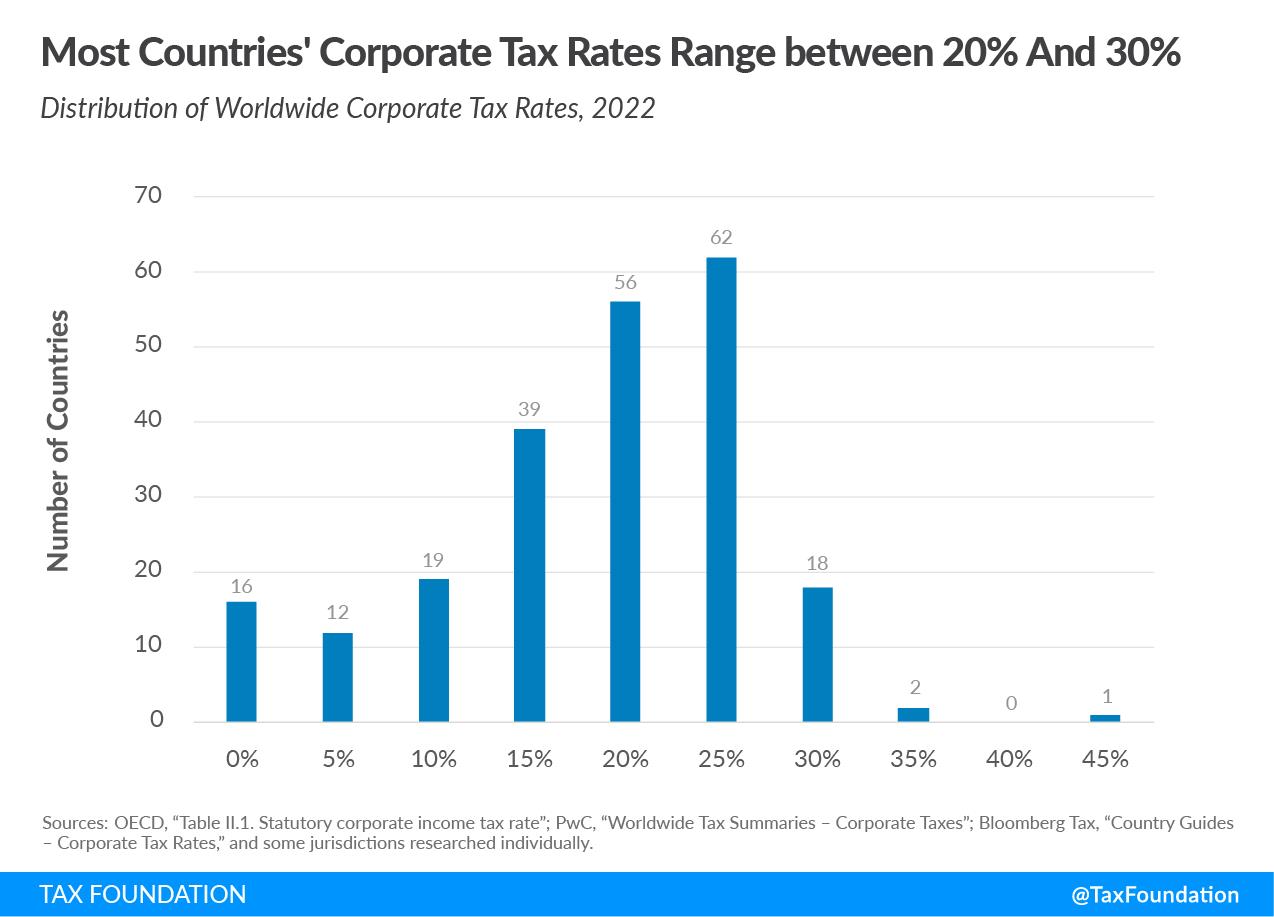
The Decline of Corporate Tax Rates since 1980 Leveled off in Recent Years
Over the past 42 years, corporate tax rates have consistently declined on a global basis. In 1980, the unweighted average worldwide statutory tax rate was 40.11 percent. Today, the average statutory rate stands at 23.37 percent—a 42 percent reduction.[15]
Despite a general decline in corporate tax rates around the world, OECD and non-OECD countries have also become more reliant on revenue from corporate income taxes. One cause for this change has been a shift in the jurisdictions included.[16] Secondly, the negative revenue impact of the decline in corporate tax rates was generally offset by reducing or abolishing tax relief policies. [17]
The weighted average statutory rate has remained higher than the simple average over this period. Prior to U.S. tax reform in 2017, the United States was largely responsible for keeping the weighted average higher, given its relatively high tax rate, as well as its significant contribution to global GDP. Figure 3 shows the significant impact the change in the U.S. corporate rate had on the worldwide weighted average. The weighted average statutory corporate income tax rate has declined from 46.52 percent in 1980 to 25.43 percent in 2022, representing a 45 percent reduction over the 42 years surveyed.
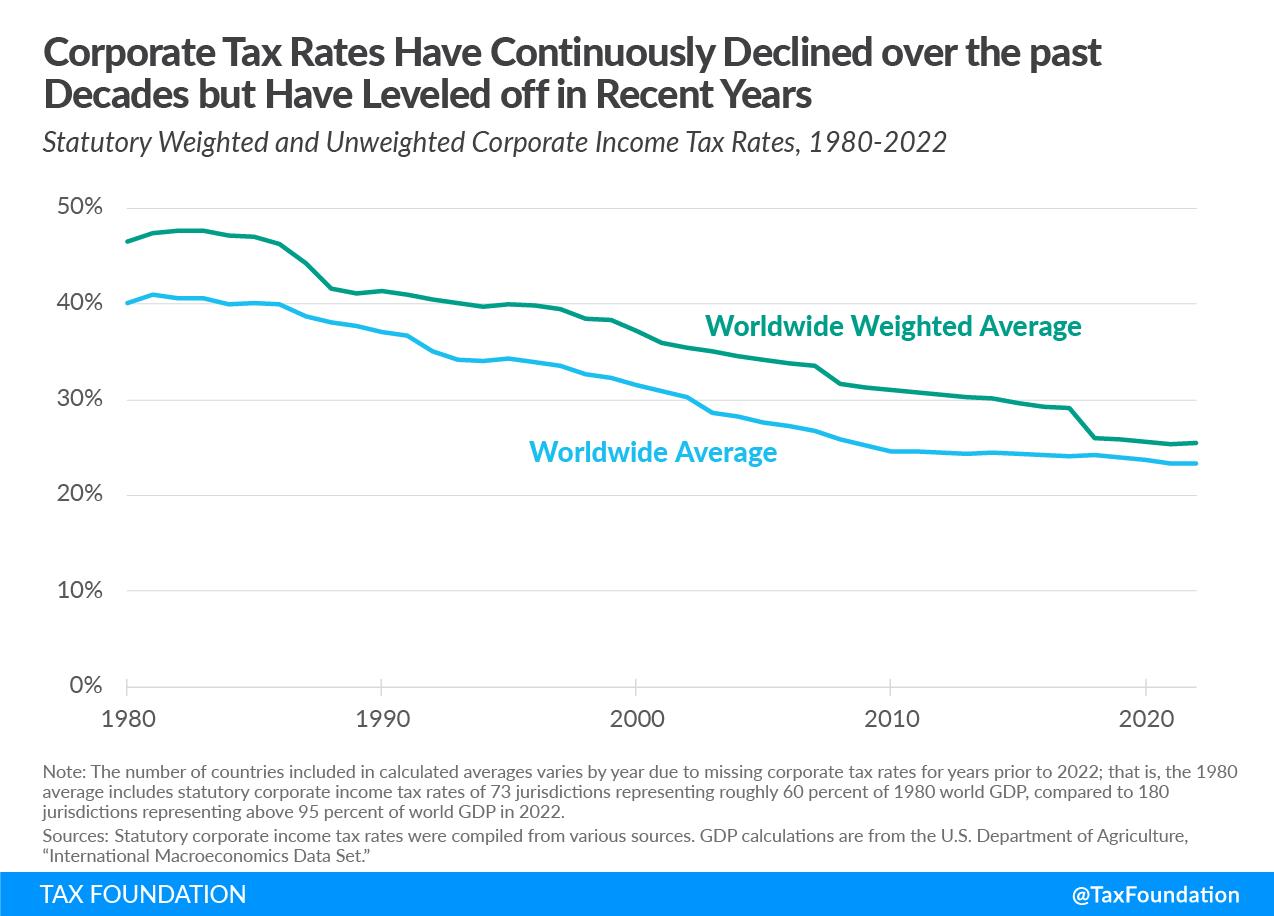
Over time, more countries have shifted to taxing corporations at rates of 30 percent or lower, with the United States following this trend with its tax changes at the end of 2017. The largest shift occurred between 1990 and 2000, with 48 percent of countries imposing a statutory rate below 30 percent in 2000 and only 27 percent of countries in the dataset imposing a statutory rate below 30 percent in 1990. This trend continued between 2000 and 2010, with 78 percent of countries imposing a statutory rate below 30 percent in 2010.[18]
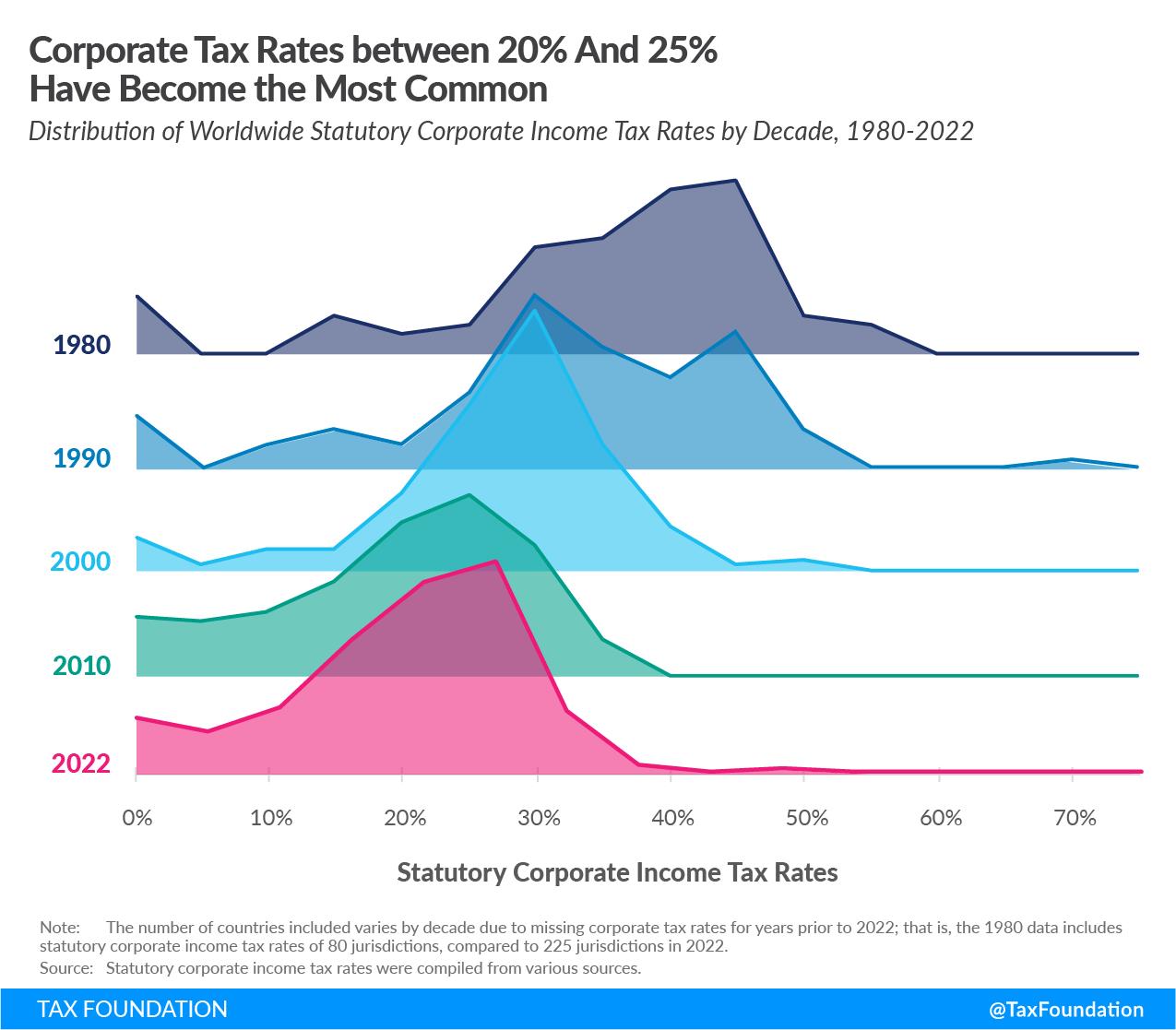
All regions saw a net decline in average statutory rates between 1980 and 2022. The average declined the most in Europe, with the 1980 average of 44.6 percent dropping to 19.74 percent—a 56 percent decline. South America has seen the smallest decline, with the average only decreasing by 23 percent, from 36.66 percent in 1980 to 28.38 percent in 2022.
South America saw two periods, 1990-2000 and 2010-2022, during which the average statutory rate increased slightly by less than one percentage point, although the average rate decreased over the full 42-year period.
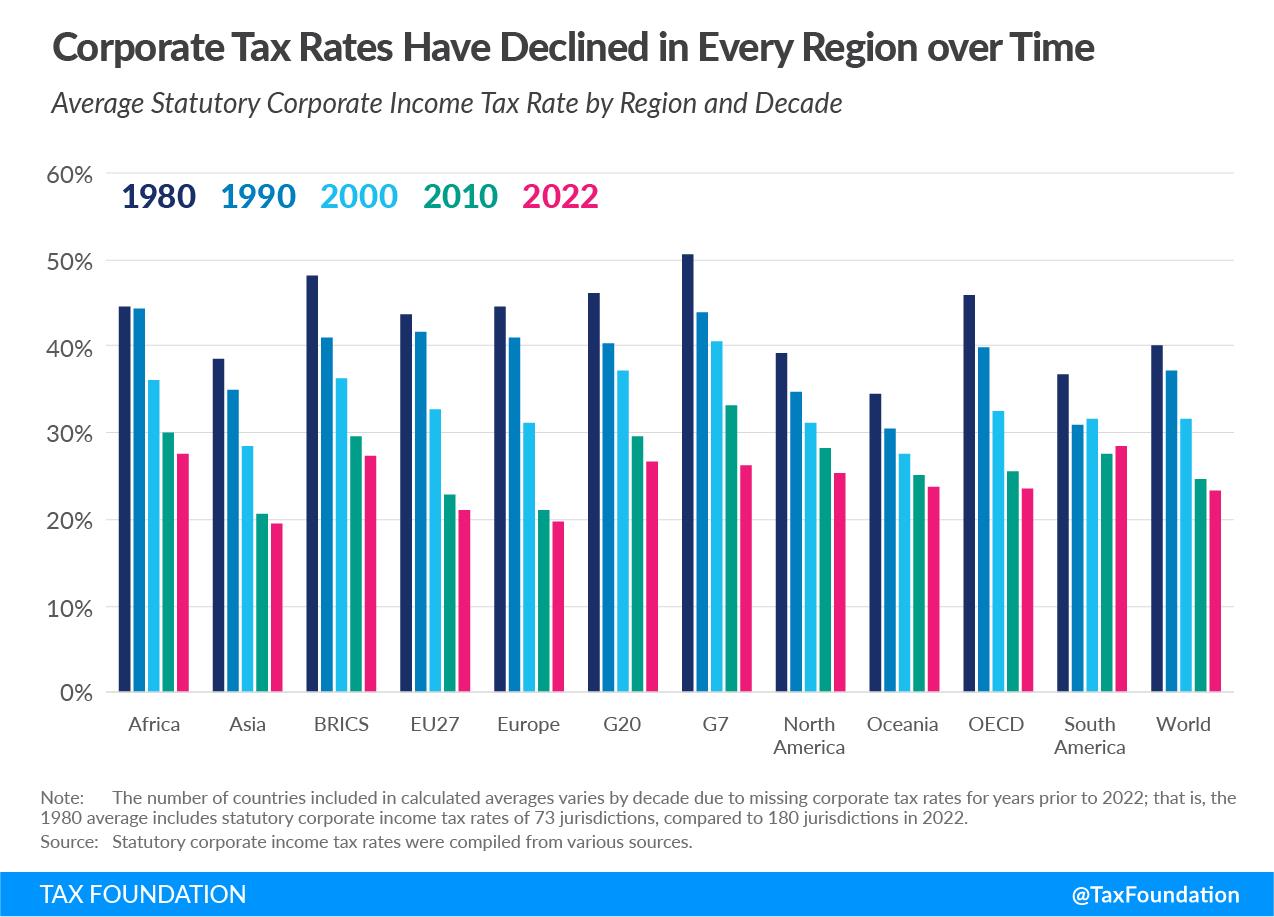
Conclusion
Worldwide and regional average top statutory corporate tax rates have declined over the past four decades but have leveled off in recent years. Of 225 jurisdictions around the world, only six have increased their top corporate income tax rate in 2022, a trend expected to hold steady as countries have more efficient tax types to turn towards.[19]
Appendix
The Dataset
Scope
The dataset compiled for this publication includes the 2022 statutory corporate income tax rates of 225 sovereign states and dependent territories around the world. Tax rates were researched only for jurisdictions that are among the around 250 sovereign states and dependent territories that have been assigned a country code by the International Organization for Standardization (ISO). As a result, zones or territories that are independent taxing jurisdictions but do not have their own country code are generally not included in the dataset.
In addition, the dataset includes historic statutory corporate income tax rates from 1980 to 2021. However, these years cover tax rates of fewer than 225 jurisdictions due to missing data points. Please let Tax Foundation know if you are aware of any sources for historic corporate tax rates that are not mentioned in this report, as we constantly strive to improve our datasets.
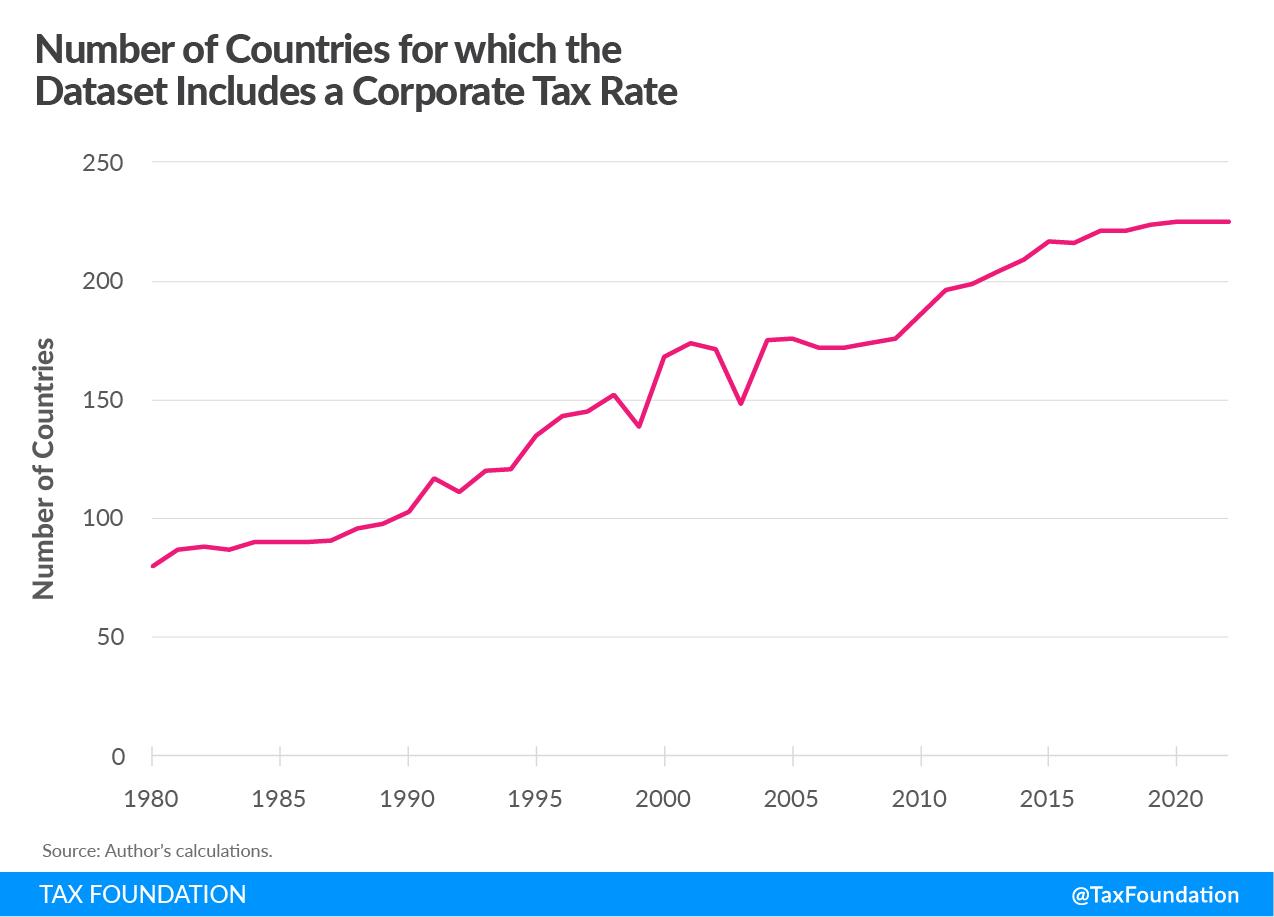
To be able to calculate average statutory corporate income tax rates weighted by GDP, the dataset includes GDP data for 180 jurisdictions. When used to calculate average statutory corporate income tax rates, either weighted by GDP or unweighted, only these 180 jurisdictions are included (to ensure the comparability of the unweighted and weighted averages).
Definition of Selected Corporate Income Tax Rate
The dataset captures standard top statutory corporate income tax rates levied on domestic businesses. This means:
- The dataset does not reflect special tax regimes, including but not limited to patent boxes, offshore regimes, or special rates for specific industries.
- A number of countries levy lower rates for businesses below a certain revenue threshold. The dataset does not capture these lower rates.
- A few countries levy gross revenue taxes on businesses instead of corporate income taxes. Since the tax rates of a corporate income tax and a gross revenue tax are not comparable, these countries are excluded from the dataset.
- Some countries have a separate tax rate for nonresident companies. This dataset does not consider nonresident tax rates that differ from the general corporate rate.
Sources
Tax Rates for the Year 2022
For OECD countries, the statutory corporate income tax rates used are the combined corporate income tax rates provided by the OECD; see OECD, “Table II.1. Statutory corporate income tax rate,” updated May 2022, https://stats.oecd.org/index.aspx?DataSetCode=Table_II1. The main source for non-OECD jurisdictions is the statutory rates provided by PwC, “Worldwide Tax Summaries – Corporate Taxes,” 2022, https://taxsummaries.pwc.com/. The study also relies on Bloomberg Tax, “Country Guides – Corporate Tax Rates,” accessed in November 2022, https://www.bloomberglaw.com/product/tax/toc_view_menu/3380. Jurisdictions that are not part of these sources were researched individually. The source for each of these jurisdictions is listed in a GitHub repository; see Tax Foundation, “worldwide-corporate-tax-rates,” GitHub, https://github.com/TaxFoundation/worldwide-corporate-tax-rates.
Tax Rates for the Years 1980-2021
Tax rates for the time frame between 1980 and 2021 are taken from a dataset compiled by the Tax Foundation over the last few years. These historic rates come from multiple sources: PwC, “Worldwide Tax Summaries – Corporate Taxes,” 2010-2019; KPMG, “Corporate Tax Rate Survey,” 1998- 2003; KPMG, “Corporate tax rates table,” 2003-2019; EY, “Worldwide Corporate Tax Guide,” 2004-2019; OECD, “Historical Table II.1 – Statutory corporate income tax rate,” 1999, http://www.oecd.org/tax/tax-policy/tax-database.htm#C_CorporateCaptial; the University of Michigan – Ross School of Business, “World Tax Database,” https://www.bus.umich.edu/otpr/otpr/default.asp; and numerous government websites.
Gross Domestic Product (GDP) for the years 1980-2022
GDP calculations are from the U.S. Department of Agriculture, “International Macroeconomics Data Set.” For years prior to 1999, U.S. Department of Agriculture, “International Macroeconomics Data Set – Historical Real Gross Domestic Product (GDP) and Growth Rates of GDP for Baseline Countries/Regions (in billions of 2010 dollars) 1980-2018,” Jan. 3, 2020, https://www.ers.usda.gov/data-products/international-macroeconomic-data-set/.
For years following 1999, U.S. Department of Agriculture, “International Macroeconomics Data Set – Projected Real Gross Domestic Product (GDP) and Growth Rates of GDP for Baseline Countries/Regions (in billions of 2015 dollars) 2012-2033,” Jan. 10, 2022, https://www.ers.usda.gov/data-products/international-macroeconomic-data-set/; and U.S. Department of Agriculture, “International Macroeconomics Data Set – Historical Real Gross Domestic Product (GDP) and Growth Rates of GDP for Baseline Countries/Regions (in billions of 2015 dollars) 2000-2020,” Jan. 10, 2022, https://www.ers.usda.gov/data-products/international-macroeconomic-data-set/.
List of all Corporate Tax Rates in 2022
| ISO3 | Country | Continent | Corporate Tax Rate |
|---|---|---|---|
| AFG | Afghanistan | AS | 20.00% |
| ALA | Aland Islands | EU | 20.00% |
| ALB | Albania | EU | 15.00% |
| DZA | Algeria | AF | 26.00% |
| ASM | American Samoa | OC | 34.00% |
| AND | Andorra | EU | 10.00% |
| AGO | Angola | AF | 25.00% |
| AIA | Anguilla | NO | 0.00% |
| ATG | Antigua and Barbuda | NO | 25.00% |
| ARG | Argentina | SA | 35.00% |
| ARM | Armenia | AS | 18.00% |
| ABW | Aruba | NO | 25.00% |
| AUS | Australia | OC | 30.00% |
| AUT | Austria | EU | 25.00% |
| AZE | Azerbaijan | AS | 20.00% |
| BHS | Bahamas | NO | 0.00% |
| BHR | Bahrain | AS | 0.00% |
| BGD | Bangladesh | AS | 30.00% |
| BRB | Barbados | NO | 5.50% |
| BLR | Belarus | EU | 18.00% |
| BEL | Belgium | EU | 25.00% |
| BLZ | Belize | NO | 0.00% |
| BEN | Benin | AF | 30.00% |
| BMU | Bermuda | NO | 0.00% |
| BTN | Bhutan | AS | 25.00% |
| BOL | Bolivia (Plurinational State of) | SA | 25.00% |
| BES | Bonaire, Sint Eustatius and Saba | NO | 25.80% |
| BIH | Bosnia and Herzegovina | EU | 10.00% |
| BWA | Botswana | AF | 22.00% |
| BRA | Brazil | SA | 34.00% |
| VGB | British Virgin Islands | NO | 0.00% |
| BRN | Brunei Darussalam | AS | 18.50% |
| BGR | Bulgaria | EU | 10.00% |
| BFA | Burkina Faso | AF | 27.50% |
| BDI | Burundi | AF | 30.00% |
| CPV | Cabo Verde | AF | 22.00% |
| KHM | Cambodia | AS | 20.00% |
| CMR | Cameroon | AF | 33.00% |
| CAN | Canada | NO | 26.21% |
| CYM | Cayman Islands | NO | 0.00% |
| CAF | Central African Republic | AF | 30.00% |
| TCD | Chad | AF | 35.00% |
| CHL | Chile | SA | 27.00% |
| CHN | China | AS | 25.00% |
| HKG | China, Hong Kong Special Administrative Region | AS | 16.50% |
| MAC | China, Macao Special Administrative Region | AS | 12.00% |
| COL | Colombia | SA | 35.00% |
| COM | Comoros | AF | 50.00% |
| COG | Congo | AF | 28.00% |
| COK | Cook Islands | OC | 20.00% |
| CRI | Costa Rica | NO | 30.00% |
| CIV | Cote d’Ivoire | AF | 25.00% |
| HRV | Croatia | EU | 18.00% |
| CUB | Cuba | NO | 35.00% |
| CUW | Curacao | NO | 22.00% |
| CYP | Cyprus | EU | 12.50% |
| CZE | Czechia | EU | 19.00% |
| COD | Democratic Republic of the Congo | AF | 30.00% |
| DNK | Denmark | EU | 22.00% |
| DJI | Djibouti | AF | 25.00% |
| DMA | Dominica | NO | 25.00% |
| DOM | Dominican Republic | NO | 27.00% |
| ECU | Ecuador | SA | 25.00% |
| EGY | Egypt | AF | 22.50% |
| SLV | El Salvador | NO | 30.00% |
| GNQ | Equatorial Guinea | AF | 35.00% |
| ERI | Eritrea | AF | 30.00% |
| EST | Estonia | EU | 20.00% |
| ETH | Ethiopia | AF | 30.00% |
| FLK | Falkland Islands (Malvinas) | SA | 26.00% |
| FRO | Faroe Islands | EU | 18.00% |
| FJI | Fiji | OC | 20.00% |
| FIN | Finland | EU | 20.00% |
| FRA | France | EU | 25.83% |
| PYF | French Polynesia | OC | 25.00% |
| GAB | Gabon | AF | 30.00% |
| GMB | Gambia | AF | 27.00% |
| GEO | Georgia | AS | 15.00% |
| DEU | Germany | EU | 29.83% |
| GHA | Ghana | AF | 25.00% |
| GIB | Gibraltar | EU | 12.50% |
| GRC | Greece | EU | 22.00% |
| GRL | Greenland | NO | 26.50% |
| GRD | Grenada | NO | 28.00% |
| GUM | Guam | OC | 21.00% |
| GTM | Guatemala | NO | 25.00% |
| GGY | Guernsey | EU | 0.00% |
| GIN | Guinea | AF | 35.00% |
| GNB | Guinea-Bissau | AF | 25.00% |
| GUY | Guyana | SA | 25.00% |
| HTI | Haiti | NO | 30.00% |
| HND | Honduras | NO | 25.00% |
| HUN | Hungary | EU | 9.00% |
| ISL | Iceland | EU | 20.00% |
| IND | India | AS | 30.00% |
| IDN | Indonesia | AS | 22.00% |
| IRN | Iran (Islamic Republic of) | AS | 25.00% |
| IRQ | Iraq | AS | 15.00% |
| IRL | Ireland | EU | 12.50% |
| IMN | Isle of Man | EU | 0.00% |
| ISR | Israel | AS | 23.00% |
| ITA | Italy | EU | 27.81% |
| JAM | Jamaica | NO | 25.00% |
| JPN | Japan | AS | 29.74% |
| JEY | Jersey | EU | 0.00% |
| JOR | Jordan | AS | 20.00% |
| KAZ | Kazakhstan | AS | 20.00% |
| KEN | Kenya | AF | 30.00% |
| KIR | Kiribati | OC | 30.00% |
| XKX | Kosovo, Republic of | EU | 10.00% |
| KWT | Kuwait | AS | 15.00% |
| KGZ | Kyrgyzstan | AS | 10.00% |
| LAO | Lao People’s Democratic Republic | AS | 20.00% |
| LVA | Latvia | EU | 20.00% |
| LBN | Lebanon | AS | 17.00% |
| LSO | Lesotho | AF | 25.00% |
| LBR | Liberia | AF | 25.00% |
| LBY | Libya | AF | 20.00% |
| LIE | Liechtenstein | EU | 12.50% |
| LTU | Lithuania | EU | 15.00% |
| LUX | Luxembourg | EU | 24.94% |
| MDG | Madagascar | AF | 20.00% |
| MWI | Malawi | AF | 30.00% |
| MYS | Malaysia | AS | 24.00% |
| MDV | Maldives | AS | 15.00% |
| MLI | Mali | AF | 30.00% |
| MLT | Malta | EU | 35.00% |
| MRT | Mauritania | AF | 25.00% |
| MUS | Mauritius | AF | 15.00% |
| MEX | Mexico | NO | 30.00% |
| FSM | Micronesia (Federated States of) | OC | 30.00% |
| MCO | Monaco | EU | 25.00% |
| MNG | Mongolia | AS | 25.00% |
| MNE | Montenegro | EU | 15.00% |
| MSR | Montserrat | NO | 30.00% |
| MAR | Morocco | AF | 31.00% |
| MOZ | Mozambique | AF | 32.00% |
| MMR | Myanmar | AS | 22.00% |
| NAM | Namibia | AF | 32.00% |
| NRU | Nauru | OC | 25.00% |
| NPL | Nepal | AS | 25.00% |
| NLD | Netherlands | EU | 25.80% |
| NCL | New Caledonia | OC | 30.00% |
| NZL | New Zealand | OC | 28.00% |
| NIC | Nicaragua | NO | 30.00% |
| NER | Niger | AF | 30.00% |
| NGA | Nigeria | AF | 30.00% |
| NIU | Niue | OC | 30.00% |
| MNP | Northern Mariana Islands | OC | 21.00% |
| NOR | Norway | EU | 22.00% |
| OMN | Oman | AS | 15.00% |
| PAK | Pakistan | AS | 29.00% |
| PAN | Panama | NO | 25.00% |
| PNG | Papua New Guinea | OC | 30.00% |
| PRY | Paraguay | SA | 10.00% |
| PER | Peru | SA | 29.50% |
| PHL | Philippines | AS | 25.00% |
| POL | Poland | EU | 19.00% |
| PRT | Portugal | EU | 31.50% |
| PRI | Puerto Rico | NO | 37.50% |
| QAT | Qatar | AS | 10.00% |
| KOR | Republic of Korea | AS | 27.50% |
| MDA | Republic of Moldova | EU | 12.00% |
| ROU | Romania | EU | 16.00% |
| RUS | Russian Federation | EU | 20.00% |
| RWA | Rwanda | AF | 30.00% |
| BLM | Saint Barthelemy | NO | 0.00% |
| SHN | Saint Helena | AF | 25.00% |
| KNA | Saint Kitts and Nevis | NO | 33.00% |
| LCA | Saint Lucia | NO | 30.00% |
| MAF | Saint Martin (French Part) | NO | 20.00% |
| VCT | Saint Vincent and the Grenadines | NO | 30.00% |
| WSM | Samoa | OC | 27.00% |
| SMR | San Marino | EU | 17.00% |
| STP | Sao Tome and Principe | AF | 25.00% |
| SAU | Saudi Arabia | AS | 20.00% |
| SEN | Senegal | AF | 30.00% |
| SRB | Serbia | EU | 15.00% |
| SYC | Seychelles | AF | 25.00% |
| SLE | Sierra Leone | AF | 25.00% |
| SGP | Singapore | AS | 17.00% |
| SXM | Sint Maarten (Dutch part) | NO | 34.50% |
| SVK | Slovakia | EU | 21.00% |
| SVN | Slovenia | EU | 19.00% |
| SLB | Solomon Islands | OC | 30.00% |
| ZAF | South Africa | AF | 28.00% |
| SSD | South Sudan | AF | 30.00% |
| ESP | Spain | EU | 25.00% |
| LKA | Sri Lanka | AS | 24.00% |
| PSE | State of Palestine | AS | 15.00% |
| SDN | Sudan | AF | 35.00% |
| SUR | Suriname | SA | 36.00% |
| SWZ | Swaziland | AF | 27.50% |
| SWE | Sweden | EU | 20.60% |
| CHE | Switzerland | EU | 19.70% |
| SYR | Syrian Arab Republic | AS | 28.00% |
| TWN | Taiwan | AS | 20.00% |
| TJK | Tajikistan | AS | 18.00% |
| THA | Thailand | AS | 20.00% |
| MKD | The former Yugoslav Republic of Macedonia | EU | 10.00% |
| TLS | Timor-Leste | OC | 10.00% |
| TGO | Togo | AF | 27.00% |
| TKL | Tokelau | OC | 0.00% |
| TON | Tonga | OC | 25.00% |
| TTO | Trinidad and Tobago | NO | 30.00% |
| TUN | Tunisia | AF | 15.00% |
| TUR | Turkey | AS | 23.00% |
| TKM | Turkmenistan | AS | 8.00% |
| TCA | Turks and Caicos Islands | NO | 0.00% |
| UGA | Uganda | AF | 30.00% |
| UKR | Ukraine | EU | 18.00% |
| ARE | United Arab Emirates | AS | 0.00% |
| GBR | United Kingdom of Great Britain and Northern Ireland | EU | 19.00% |
| TZA | United Republic of Tanzania | AF | 30.00% |
| USA | United States of America | NO | 25.81% |
| VIR | United States Virgin Islands | NO | 23.10% |
| URY | Uruguay | SA | 25.00% |
| UZB | Uzbekistan | AS | 15.00% |
| VUT | Vanuatu | OC | 0.00% |
| VEN | Venezuela (Bolivarian Republic of) | SA | 34.00% |
| VNM | Viet Nam | AS | 20.00% |
| WLF | Wallis and Futuna Islands | OC | 0.00% |
| YEM | Yemen | AS | 20.00% |
| ZMB | Zambia | AF | 30.00% |
| ZWE | Zimbabwe | AF | 24.72% |
|
Notes: Continent abbreviations are as follows: “AF” is Africa, “AS” is Asia, “EU” is Europe, “OC” is Oceania, “NO” is North America, and “SA” is South America. Countries are assigned to continents based on ISO standards; see DataHub.io, “Comprehensive country codes: ISO 3166, ITU, ISO 4217 currency codes and many more,” https://datahub.io/core/country-codes#resource-country-codes_zip.
Sources: Statutory corporate income tax rates are from OECD, “Table II.1. Statutory corporate income tax rate,” PwC, “Worldwide Tax Summaries – Corporate Taxes;” Bloomberg Tax, “Country Guides – Corporate Tax Rates”; and some jurisdictions researched individually, see Tax Foundation, “worldwide-corporate-tax-rates.” |
|||
References
[1] Unless otherwise noted, calculated averages of statutory corporate income tax rates only include jurisdictions for which GDP data is available for all years between 1980 and 2022. For 2022, the dataset includes statutory corporate income tax rates of 225 jurisdictions, but GDP data is available for only 180 of these jurisdictions, reducing the number of jurisdictions included in calculated averages to 180. For years prior to 2022, the number of countries included in calculated averages varies by year due to missing corporate tax rates; that is, the 1980 average includes statutory corporate income tax rates of 73 jurisdictions, compared to 180 jurisdictions in 2022.
[2] Statutory corporate income tax rates are from OECD, “Table II.1. Statutory corporate income tax rate,” updated May 2022, https://stats.oecd.org/index.aspx?DataSetCode=Table_II1; PwC, “Worldwide Tax Summaries – Corporate Taxes,” 2022, https://taxsummaries.pwc.com/. Bloomberg Tax, “Country Guides – Corporate Tax Rates,” accessed November 2022, https://www.bloomberglaw.com/product/tax/toc_view_menu/3380; and researched individually, see Tax Foundation, “worldwide-corporate-tax-rates,” GitHub, https://github.com/TaxFoundation/worldwide-corporate-tax-rates. GDP calculations are from the U.S. Department of Agriculture, “International Macroeconomics Data Set,” Jan. 10, 2022, https://www.ers.usda.gov/data-products/international-macroeconomic-data-set/.
[3] Kari Jahnsen and Kyle Pomerleau, “Corporate Income Tax Rates around the World, 2017,” Tax Foundation, Sept. 7, 2017, https://taxfoundation.org/corporate-income-tax-rates-around-the-world-2017/.
[4] The Caribbean Netherlands, Bonaire, Sint Eustatius, and Saba, are also subject to Dutch corporate income tax and therefore indirectly impacted by this tax increase.
[5] PwC, “Worldwide Tax Summaries – Austria,” 2022, https://taxsummaries.pwc.com/austria/corporate/significant-developments.
[6] HM Revenue and Customs, “Corporation Tax charge and rates from 1 April 2022 and Small Profits Rate and Marginal Relief from 1 April 2023,” Mar. 3, 2021, https://www.gov.uk/government/publications/corporation-tax-charge-and-rates-from-1-april-2022-and-small-profits-rate-and-marginal-relief-from-1-april-2023/corporation-tax-charge-and-rates-from-1-april-2022-and-small-profits-rate-and-marginal-relief-from-1-april-2023.
[7] PwC, “Worldwide Tax Summaries – Turkey,” 2022, https://taxsummaries.pwc.com/austria/corporate/significant-developments.
[8] OECD, “Tax Policy Reforms 2022: OECD and Selected Partner Economies,” OECD Publishing, Paris, 2022, https://doi.org/10.1787/067c593d-en.
[9] PwC, “Worldwide Tax Summaries – South Africa,” 2022, https://taxsummaries.pwc.com/south-africa/corporate/taxes-on-corporate-income.
[10] As no averages are presented in this section, it covers all 225 jurisdictions for which corporate income tax rates were found in 2022 (thus including jurisdictions for which GDP data was not available).
[11] This average is lower than the average of the 180 jurisdictions because many of the jurisdictions for which no GDP data is available are small economies with low corporate income tax rates.
[12] Where applicable, similar combinations of national and subnational rates are included in this dataset. For example, the combined German corporate tax rate is 29.83 percent which includes both the federal rate of 15 percent and accounts for municipal trade taxes which range from 14 to 17 percent.
[13] BRICS is a group of countries with major emerging economies. The members of this group are Brazil, Russia, India, China, and South Africa.
[14] As no averages are presented in this chapter, it covers all 225 jurisdictions for which 2022 corporate income tax rates were found (thus including jurisdictions for which GDP data was not available).
[15] Historical data comes from multiple sources: PwC, “Worldwide Tax Summaries – Corporate Taxes,” 2010-2019; KPMG, “Corporate Tax Rate Survey,” 1998- 2003; KPMG, “Corporate tax rates table,” 2003-2019; EY, “Worldwide Corporate Tax Guide,” 2004-2019; OECD, “Historical Table II.1 – Statutory corporate income tax rate,” 1999, http://www.oecd.org/tax/tax-policy/tax-database.htm#C_CorporateCaptial; the University of Michigan – Ross School of Business, “World Tax Database,” https://www.bus.umich.edu/otpr/otpr/default.asp; and numerous government websites.
[16] Daniel Bunn, “Sources of Government Revenue in the OECD,” Tax Foundation, 2022, https://taxfoundation.org/publications/sources-of-government-revenue-in-the-oecd/
[17] OECD, “Tax revenue trends 1965-2020”, in Revenue Statistics 2021: The Initial Impact of COVID-19 on OECD Tax Revenues, OECD Publishing, Paris, 2021, https://read.oecd-ilibrary.org/taxation/revenue-statistics-2021_b5975909-en#page10.
[18] This section of the report covers all 225 jurisdictions for which 2022 corporate income tax rates were found (thus including jurisdictions for which GDP data was not available).
[19] Asa Johansson, Christopher Heady, Jens Arnold, Bert Brys, and Laura Vartia, “Tax and Economic Growth,” OECD, July 11, 2008, https://www.oecd.org/tax/tax-policy/41000592.pdf; see also, Alex Durante, “Reviewing Recent Evidence of the Effect of Taxes on Economic Growth,” Tax Foundation, May 21, 2021, https://taxfoundation.org/reviewing-recent-evidence-effect-taxes-economic-growth/.
Read MoreBy: Kevin Kaufman
Title: Corporate Tax Rates around the World, 2022
Sourced From: taxfoundation.org/corporate-tax-rates-by-country-2022/
Published Date: Tue, 13 Dec 2022 09:55:15 +0000
----------------------






